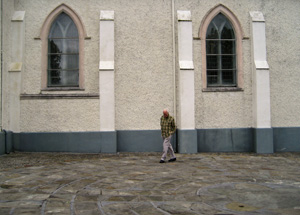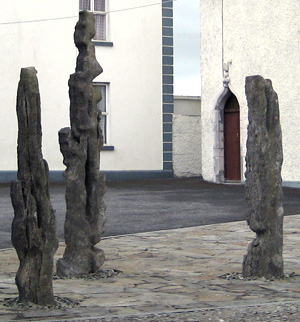
Visit our STORE
Knots and Labyrinths
In Ireland our plans and routes changed from day to day. But one day, zooming from Westport to meet Sinead for lunch in Galway City, we found ourselves on N84 passing through Shrule, County Mayo. Shrule is the parish where my great-grandmother Maggie Keville was baptized. We spotted a church. "Stop here," I said and Jim jammed on the brakes.
It was your basic small town church without a name.* But along the side was their pride and joy — a labyrinth, made of Mayo sandstone and limestone, created to celebrate the millennium.
 The
ancient form of the labyrinth has become popular as a meditation
and centering tool. It isn't a maze — there are no dead ends. You
simply start at the entrance, stay in your lane on the convoluted
circuit and wind up in the center. We walked the route in the chilly
mist.
The
ancient form of the labyrinth has become popular as a meditation
and centering tool. It isn't a maze — there are no dead ends. You
simply start at the entrance, stay in your lane on the convoluted
circuit and wind up in the center. We walked the route in the chilly
mist.
I thought about it. The cool geometric form defines a sacred space for all times, for all peoples. But it doesn't feel particularly Irish. The Celtic knot, cliched as it is, better symbolizes the Irish love of complication and ambiguity and passionate entanglement. Interlocking trinities of relationships... like, husband, wife, oldest son: the perfect storm of maddening adoration.
It sounds trivial to reduce a culture to its road systems but the Irish
are unapolegetic that their signage is approximate and that every
major intersection is a circle that multiplies the possibilities
rather than narrows them down. North, south, east, west? No... only
confusing references to Waterford, Limerick, and Galway. The only
sign we encountered that said "east" was in the snake's nest of highways
around Cork. It meant something about Ringaskiddy being eventually
east of Cork, but went south and did not actually put us on the easterly
route to Cobh. Knowing where you are going is about instinct not  analysis.
And isn't every place a sacred place, then, if you've circled around
it long enough?
analysis.
And isn't every place a sacred place, then, if you've circled around
it long enough?
At the edge of the labyrinth, unnoted, unmarked, were a trinity of standing stones. Had they always been there — ancient Celtic monuments that denoted a sacred space where the church should be built? Or a modern tribute to the Celtic past? What would be the point of telling us? We can walk the one true path into the center of the labyrinth, but the mystery of the Irish character stands outside, looking on.
5.27.07
Thumbs Up if you liked this entry.
The design of the Shrule labyrinth is medieval, with 11 circuits and is 13 meters or 42 feet in diameter. The walking path itself is 275 meters (300 yards). "Walking the labyrinth clears the mind, calms people in the throes of life transitions, it helps see life in the context of a path, a pilgrimage. One can realise we are not human beings on a spiritual path but spiritual beings on a human path" [Shrule labyrinth brochure].
Shrule's Millennial Labyrinth by Willie McHugh, Mayo News
*St Joseph's Roman Catholic Church. Rev. Michael Crosbie